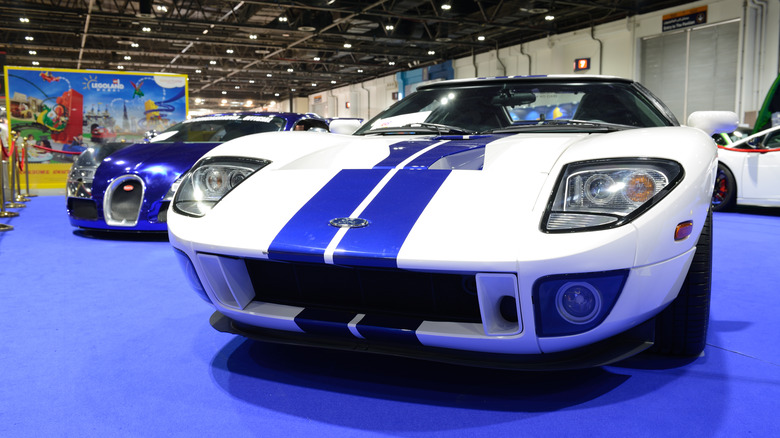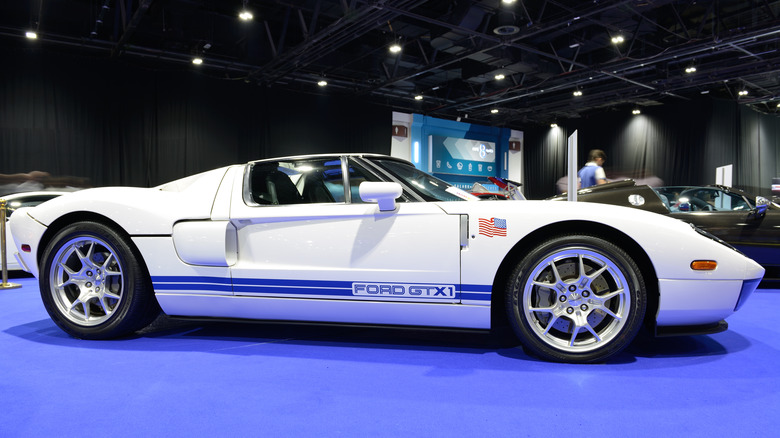What Ever Happened To The Ford GTX1 Roadster, And What's One Worth Today?
In 2005, Ford wanted a product to enter into the Specialty Equipment Market Association (SEMA) Show in Las Vegas, Nevada. The brand already had a long list of iconic cars, but it needed something special for SEMA. Kip Ewing, an engineer for the Ford GT project took a stab at redesigning the GT. Once Ewing got approval from his bosses, he sent his designs to a specialist in the industry to collaborate. The end result was the GTX1 Roadster.
Ford intended the roadster to be for show only, creating it exclusively for the SEMA Show. However, when people saw it at the car show, checkbooks opened and an opportunity to mass-produce the experimental car presented itself. To keep up with the demand, Ford contracted the Gennadi Design Group to produce a limited number of working models. The design group made some modifications to the original GT design, including crafting a new carbon fiber targa top along with a modified V8 engine that boosted the original output from 550 horsepower to 700 horsepower.
Gennadi Design group produced the GTX1 for two years, culminating in a total of roughly 100 models. Four of those models are actually identical to the version of the car seen at the SEMA show. The original plan was to make 600 cars with 100 of them being SEMA Edition replicas. Unfortunately, by the end of the two-year production time table, Gennadi Design Group didn't receive enough orders. It's a rare car, to say the least.
Who helped create the Ford GTX1 Roadster?
When Kip Ewing came up with the design for the new Ford GT, he based it on the old GT40, which not only had some of the coolest features but also won the 24 Hours of Sebring in 1966. The man he entrusted with producing such an attractive car was none other than Mark Gerish, who dropped out of high school to focus all of his attention in his passion of automobile bodywork. Thankfully, Gerish's gamble paid off, because he eventually went on to be the founder of the Genaddi Design Group.
Ewing flew out to Wisconsin, where Gerisch lived and the Genaddi Design Group is based, every weekend to hammer out the details for the SEMA GTX1. They were originally going to use the open-car design that the GT40 sported back in the '60s, but they decided to go in a slightly different direction. Despite the demand for the new car, Ford had no intention of producing more than the one they funded for SEMA. So Gerisch took it upon himself, along with Ford's blessing, to produce the car on demand. Ford gave him and his design firm a two-year contract.
How much is the GTX1 worth today?
Since the GTX1 had such a limited production, it's an incredibly difficult car to find for sale. Since only a handful were ever made, and few owners want to part with something so precious, that's definitely going to inflate its price tag. However, there are those rare few who are fine with parting with their prized possession. One SEMA Edition GTX1 was on auction in 2022 and sold for between $850,000 and $1,000,000. For at least three-quarters of a million dollars, that's an expensive collector's item, which is more inline with what the second generation Ford GT could go for at auction.
Another model with 16,000 miles on it sold in 2023 for $515,000. It wasn't a SEMA Edition, but it did have red SEMA wheels, matching the exterior's paint job. Four years before that, a 2006 model sold for $355,000. While it had a similar paint job, it didn't sport the red SEMA wheels. Even so, that's barely a drop in the bucket when compared to the 2019 Ford GT lightweight that brought over $1 million at auction.


